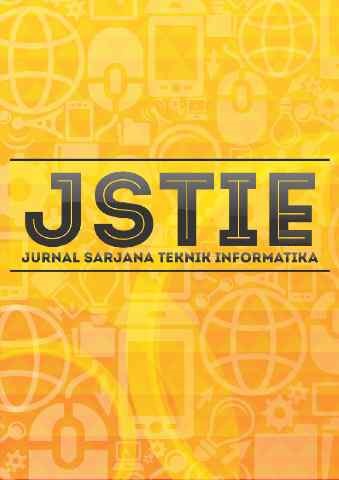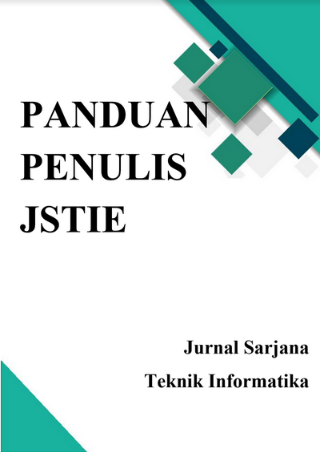Segmentasi Luka Diabetes Menggunakan Algoritma Contour Image Processing
DOI:
https://doi.org/10.12928/jstie.v9i2.20226Keywords:
Digital planimetry, Image processing, HSV, Luka diabetes, Contour imageAbstract
Pengukuran luas luka pada penderita diabetes masih menggunakan cara manual dengan penggaris luka. Sedangkan penggaris yang ditempelkan keluka akan menjadi contaminated agent yang dapat menularkan infeksi pada penderita lain. Metode pengukuran digital diperlukan agar masalah tersebut bisa terselesaikan. Tetapi untuk memperjelas batas antara luka dan kulit diperlukan ketelitian dan akurasi yang tinggi. Untuk itu diperlukan metode pencitraan yang dapat melakukan segmentasi antara batas luka dan kulit paada pasien diabetes berbasis digital yang dinamakan digital planimetry. Penelitian ini menggunakan algoritma contour image processing dari nilai hue, saturation, value (HSV). Kemudian melakukan iterasi sebanyak 5 kali dan filter gamma. Sehingga mendapatkan hasil segmentasi luka. Kesimpulan akhir dari penelitian ini adalah segementasi dengan metode ini belum dapat melakukan segementasi luka dengan baik dan diperlukan tambahan nilai masking yang lebih luas, akan tetapi hasil iterasi ke 5 mendapatkan error terkecil yaitu 0.002%. Pencitraan digital yang dilakukan dalam penelitian ini dapat dikembangkan untuk menjadi alat ukur luas luka pasien diabetes berbasis digital.References
S. I. Imelda, “Faktor-Faktor Yang Mempengaruhi Terjadinya diabetes Melitus di Puskesmas Harapan Raya Tahun 2018,†SCJ, vol. 8, no. 1, pp. 28–39, May 2019, doi: 10.35141/scj.v8i1.406.
N. C. Schaper, J. J. Van Netten, J. Apelqvist, B. A. Lipsky, K. Bakker, and on behalf of the International Working Group on the Diabetic Foot (IWGDF), Prevention and management of foot problems in diabetes: a Summary Guidance for Daily Practice 2015, based on the IWGDF Guidance Documents: Prevention and Management of Foot Problems in Diabetes, vol. 32. John Wiley & Sons, Ltd, 2016.
S. A. Bus et al., “Effect of Custom-Made Footwear on Foot Ulcer Recurrence in Diabetes: A multicenter randomized controlled trial,†Diabetes Care, vol. 36, no. 12, pp. 4109–4116, Dec. 2013, doi: 10.2337/dc13-0996.
A. A. H. Sulistyo, “MANAGEMENT OF DIABETIC FOOT ULCER: A LITERATURE REVIEW,†Jurnal Keperawatan Indonesia, vol. 21, no. 2, pp. 84–93, Aug. 2018, doi: 10.7454/jki.v21i2.634.
K. J. Williams, V. Sounderajah, B. Dharmarajah, A. Thapar, and A. H. Davies, “Simulated Wound Assessment Using Digital Planimetry versus Three-Dimensional Cameras: Implications for Clinical Assessment,†Annals of Vascular Surgery, vol. 41, pp. 235–240, May 2017, doi: 10.1016/j.avsg.2016.10.029.
L. B. Jørgensen, J. A. Sørensen, G. B. Jemec, and K. B. Yderstraede, “Methods to assess area and volume of wounds - a systematic review: Review of methods to assess wound size,†Int Wound J, vol. 13, no. 4, pp. 540–553, Aug. 2016, doi: 10.1111/iwj.12472.
P. Foltynski, “Ways to increase precision and accuracy of wound area measurement using smart devices: Advanced app Planimator,†PLoS ONE, vol. 13, no. 3, p. e0192485, Mar. 2018, doi: 10.1371/journal.pone.0192485.
K. S. Babu, K. Y. B. Ravi, and S. Sabut, “An improved watershed segmentation by flooding and pruning algorithm for assessment of diabetic wound healing,†in 2017 2nd IEEE International Conference on Recent Trends in Electronics, Information & Communication Technology (RTEICT), Bangalore, May 2017, pp. 679–683, doi: 10.1109/RTEICT.2017.8256683.
M. F. Ahmad Fauzi, I. Khansa, K. Catignani, G. Gordillo, C. K. Sen, and M. N. Gurcan, “Computerized segmentation and measurement of chronic wound images,†Computers in Biology and Medicine, vol. 60, pp. 74–85, May 2015, doi: 10.1016/j.compbiomed.2015.02.015.
S. Niu, Q. Chen, L. de Sisternes, Z. Ji, Z. Zhou, and D. L. Rubin, “Robust noise region-based active contour model via local similarity factor for image segmentation,†Pattern Recognition, vol. 61, pp. 104–119, Jan. 2017, doi: 10.1016/j.patcog.2016.07.022.
W. Xiong et al., “Foreground-Aware Image Inpainting,†in 2019 IEEE/CVF Conference on Computer Vision and Pattern Recognition (CVPR), Long Beach, CA, USA, Jun. 2019, pp. 5833–5841, doi: 10.1109/CVPR.2019.00599.
L. Wang, Y. Chang, H. Wang, Z. Wu, J. Pu, and X. Yang, “An active contour model based on local fitted images for image segmentation,†Information Sciences, vol. 418–419, pp. 61–73, Dec. 2017, doi: 10.1016/j.ins.2017.06.042.
Y. A. Gerhana, W. B. Zulfikar, A. H. Ramdani, and M. A. Ramdhani, “Implementation of Nearest Neighbor using HSV to Identify Skin Disease,†IOP Conf. Ser.: Mater. Sci. Eng., vol. 288, p. 012153, Jan. 2018, doi: 10.1088/1757-899X/288/1/012153.
R. B. Shi, J. Qiu, and V. Maida, “Towards algorithmâ€enabled home wound monitoring with smartphone photography: A hueâ€saturationâ€value colour space thresholding technique for wound content tracking,†Int Wound J, vol. 16, no. 1, pp. 211–218, Feb. 2019, doi: 10.1111/iwj.13011.
V. Grandi et al., “ALA-PDT exerts beneficial effects on chronic venous ulcers by inducing changes in inflammatory microenvironment, especially through increased TGF-beta release: A pilot clinical and translational study,†Photodiagnosis and Photodynamic Therapy, vol. 21, pp. 252–256, Mar. 2018, doi: 10.1016/j.pdpdt.2017.12.012.
R. C. op ‘t Veld et al., “Thermosensitive biomimetic polyisocyanopeptide hydrogels may facilitate wound repair,†Biomaterials, vol. 181, pp. 392–401, Oct. 2018, doi: 10.1016/j.biomaterials.2018.07.038.
E. Sirazitdinova and T. M. Deserno, “System design for 3D wound imaging using low-cost mobile devices,†Orlando, Florida, United States, Mar. 2017, p. 1013810, doi: 10.1117/12.2254389.
A. Gupta, “Real time wound segmentation/management using image processing on handheld devices,†JCM, vol. 17, no. 2, pp. 321–329, Apr. 2017, doi: 10.3233/JCM-170706.
B. Bozorgtabar, S. Sedai, P. K. Roy, and R. Garnavi, “Skin lesion segmentation using deep convolution networks guided by local unsupervised learning,†IBM J. Res. & Dev., vol. 61, no. 4/5, p. 6:1-6:8, Jul. 2017, doi: 10.1147/JRD.2017.2708283.
R. Mishra and O. Daescu, “Deep learning for skin lesion segmentation,†in 2017 IEEE International Conference on Bioinformatics and Biomedicine (BIBM), Kansas City, MO, Nov. 2017, pp. 1189–1194, doi: 10.1109/BIBM.2017.8217826.
F. Li, C. Wang, X. Liu, Y. Peng, and S. Jin, “A Composite Model of Wound Segmentation Based on Traditional Methods and Deep Neural Networks,†Computational Intelligence and Neuroscience, vol. 2018, pp. 1–12, May 2018, doi: 10.1155/2018/4149103.
E. Hamuda, B. Mc Ginley, M. Glavin, and E. Jones, “Automatic crop detection under field conditions using the HSV colour space and morphological operations,†Computers and Electronics in Agriculture, vol. 133, pp. 97–107, Feb. 2017, doi: 10.1016/j.compag.2016.11.021.
M. Kumar and S. R. Jindal, “Fusion of RGB and HSV colour space for foggy image quality enhancement,†Multimed Tools Appl, vol. 78, no. 8, pp. 9791–9799, Apr. 2019, doi: 10.1007/s11042-018-6599-8.
M. Jawahar, L. J. Anbarasi, S. G. Jasmine, and M. Narendra, “Diabetic Foot Ulcer Segmentation using Color Space Models,†in 2020 5th International Conference on Communication and Electronics Systems (ICCES), COIMBATORE, India, Jun. 2020, pp. 742–747, doi: 10.1109/ICCES48766.2020.9138024.
M. Elmogy, A. Khalil, A. Shalaby, A. Mahmoud, M. Ghazal, and A. El-Baz, “Chronic Wound Healing Assessment System Based on Color and Texture Analysis,†in 2019 IEEE International Conference on Imaging Systems and Techniques (IST), Abu Dhabi, United Arab Emirates, Dec. 2019, pp. 1–5, doi: 10.1109/IST48021.2019.9010586.
Y. Li, J. Zhang, P. Gao, L. Jiang, and M. Chen, “Grab Cut Image Segmentation Based on Image Region,†in 2018 IEEE 3rd International Conference on Image, Vision and Computing (ICIVC), Chongqing, Jun. 2018, pp. 311–315, doi: 10.1109/ICIVC.2018.8492818.
C. Rother, V. Kolmogorov, and A. Blake, “‘GrabCut’ — Interactive Foreground Extraction using Iterated Graph Cuts,†p. 6.
Downloads
Published
Issue
Section
License
License and Copyright Agreement
In submitting the manuscript to the journal, the authors certify that:
- They are authorized by their co-authors to enter into these arrangements.
- The work described has not been formally published before, except in the form of an abstract or as part of a published lecture, review, thesis, or overlay journal. Please also carefully read Journal Posting Your Article Policy.
- The work is not under consideration for publication elsewhere.
- The work has been approved by all the author(s) and by the responsible authorities – tacitly or explicitly – of the institutes where the work has been carried out.
- They secure the right to reproduce any material that has already been published or copyrighted elsewhere.
- They agree to the following license and copyright agreement.
Copyright
Authors who publish with Jurnal Sarjana Teknik Informatika agree to the following terms:
- Authors retain copyright and grant the journal right of first publication with the work simultaneously licensed under a Creative Commons Attribution License (CC BY-SA 4.0) that allows others to share the work with an acknowledgement of the work's authorship and initial publication in this journal.
- Authors are able to enter into separate, additional contractual arrangements for the non-exclusive distribution of the journal's published version of the work (e.g., post it to an institutional repository or publish it in a book), with an acknowledgement of its initial publication in this journal.
- Authors are permitted and encouraged to post their work online (e.g., in institutional repositories or on their website) prior to and during the submission process, as it can lead to productive exchanges, as well as earlier and greater citation of published work.








